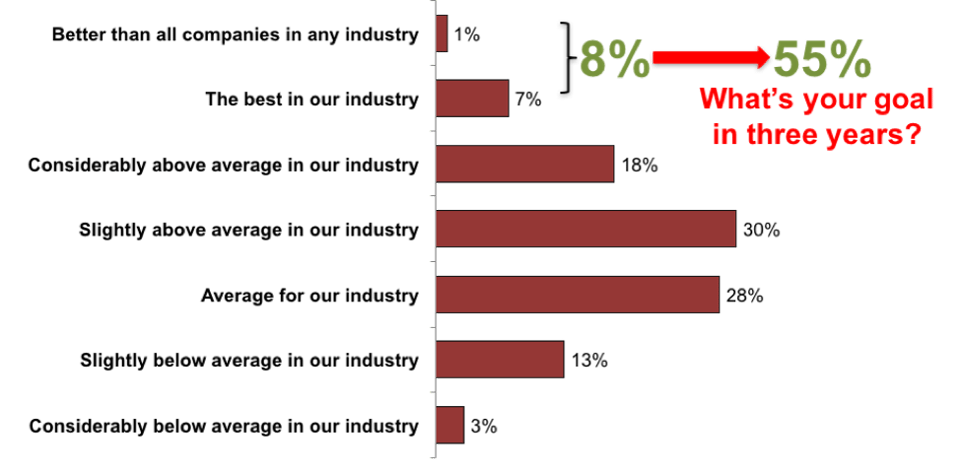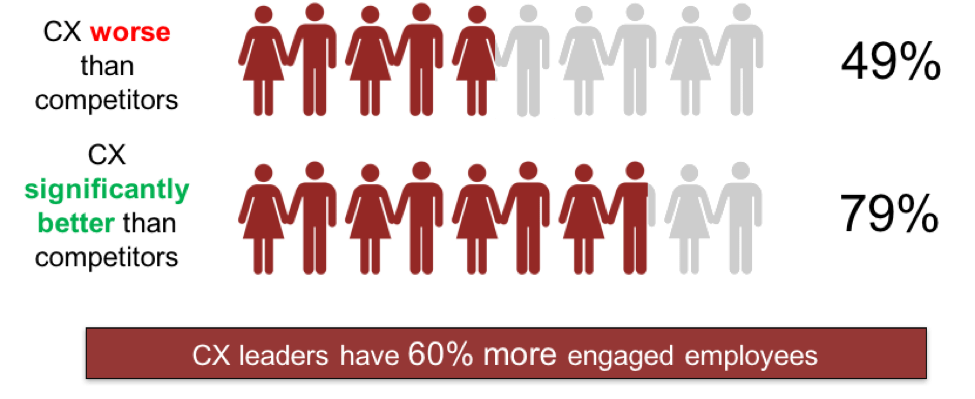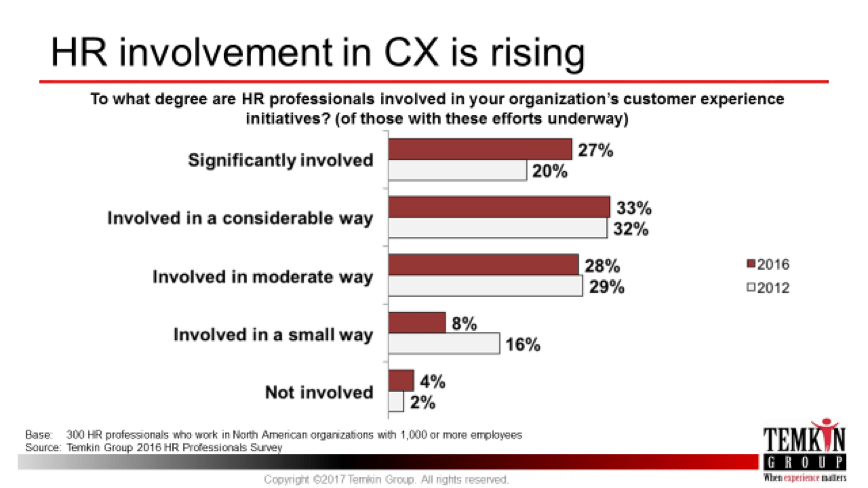
Competitive Advantage: The Power of Embracing Neurodiversity
June 27, 2017
Three Keys To Effectively Managing Remote Workers [Infographic]
July 25, 2017
*As originally seen on Forbes.com
How would your customers describe their experience with your firm?
Please take a moment and rate the Customer Experience (CX) that you believe you deliver:
- Better than all companies in any industry
- The best in our industry
- Considerably above average in our industry
- Slightly above average in our industry
- Average for our industry
- Slightly below average in our industry
- Considerably below average in our industry
Now, what CX would you like to deliver within 3 years?

Credit: Temkin Group Q1 2017 CX Management Survey
Data: Q1 2017 CX Management Survey of 180 organizations with $500 million or more in annual revenues
According to Aimee Lucas, Customer Experience Transformist and VP at Temkin Group, 55% of all the companies surveyed want to be best in their industry or better than all companies in any industry when it comes to the level of CX they deliver they deliver within three years. That’s a big crowd wanting to get into a small, small slot.
As Aimee and I caught up at the recent North American Employee Engagement Awards it became crystal clear: it’s time to stress the connection between Employee Engagement (EE) and CX. Now.
Customers today have a louder voice (think Yelp and other rating sites), have access to more information on you and your competitors, and as a result expect an increasingly awesome experience. And they should.
Meanwhile your competitors are launching new products and services faster than ever before, and are consistently raising the bar on CX. And they should.
So what’s an organization to do?
Arm yourself with these 3 CX-Boosting Strategies!
3 CX-Boosting Strategies
1) Become A CX Leader — By Focusing First On Employees
CX leaders (companies whose CX is significantly better than their competitors) have more engaged employees. Here’s what Temkin Group found:

Credit: Temkin Group Employee Engagement Benchmark Study, 2017
Base: 5,552 U.S. consumers employed in for-profit organizations
How exactly does engagement work? What happens in the brain when we are engaged?
Engagement comes from feeling good, from passion for the company, from meaningful work, from attaching part of one’s identity with their job. And this comes down to some neurotransmitters and a hormone. As leaders when we intentionally help the brains of our employees to generate dopamine, serotonin, and oxytocin we create good feelings for the organization. Dopamine (anticipation of reward) and serotonin (feeling good, well-being) and oxytocin (bonding, feeling connected to others) can be created via a number of programs in your Cultural GAME Plan.
So how do you become a CX leader and get engaged employees? This is where HR comes in…
2) Get HR To Connect EE And CX
HR owns the cultural programs, so it’s key that they are first looped into Employee Engagement (EE) so they can help support CX. First a strong mission, vision, values sets the tone for your tribal purpose and code of conduct (oxytocin). Next, acknowledging employees for being models of your values creates social validation (dopamine and serotonin). There are many more ways that you can read about in my many blogs on employee engagement and in #3 below.
Next, when HR runs regular SBM Indexes, you can easily diagnose and cure and engagement dis-eases so you can continuously raise your engagement bar.
It matters, it’s a reflection of them and what they believe in, who they are, how they show up in the world.
According to Temkin Group’s research when HR is significantly involved in CX the organization is 50% more likely to be a CX leader. Wow.
Is HR involved in CX at your organization?

Credit: Temkin Group 2016 HR Professionals Survey
Which brings us to the next item to check on our list, specifics for creating EE and CX.
3) Clarify Exactly How/Where HR Can Support EE And CX
Here are some ways that HR can forge the EE-CX link…
- Employee communications – rich in safety, belonging, mattering and boosting positive feelings
- Employee training & new hire onboarding – see my blog on how to ensure key emotional touchpoints in the onboarding process
- Performance motivation – learn how to create intrinsic motivation in this blog
- Awards, celebrations, incentives – learn how to celebrate and incent in these blogs
- Employee listening programs – learn how to be a better listener in this blog
- Middle manager engagement efforts – learn how to engage leaders and the cost of low leader engagement in this blog
- Recruiting & hiring processes – learn the latest way to recruit with self-revealing questions here
All of the above examples and blogs will help you keep the brains of your employees in their Smart State, which will in turn help your customers spend more time there too! Smart State = Engaged, Aligned, Tribal, Together.




